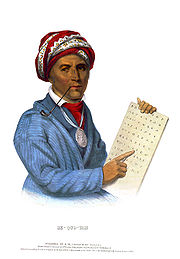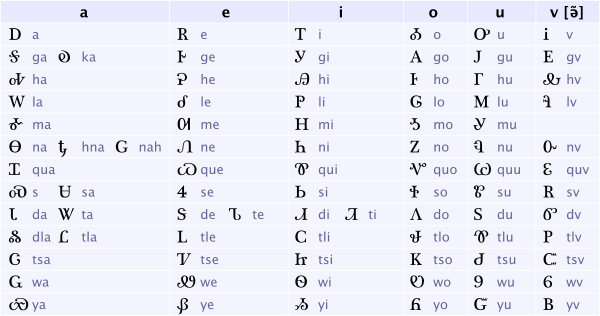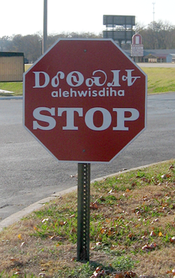- Cherokee syllabary
-
Cherokee Type Syllabary Languages Cherokee language Time period 1820s[1]-present Parent systems none- Cherokee
ISO 15924 Cher, 445 Direction Left-to-right Unicode alias Cherokee Unicode range U+13A0–U+13FF Note: This page may contain IPA phonetic symbols. The Cherokee syllabary is a syllabary invented by Sequoyah to write the Cherokee language in the late 1810s and early 1820s. His creation of the syllabary is particularly noteworthy in that he could not previously read any script. He first experimented with logograms, but his system later developed into a syllabary. In his system, each symbol represents a syllable rather than a single phoneme, the 85 (originally 86)[1] characters in the Cherokee syllabary provide a suitable method to write Cherokee. Some symbols do resemble the Latin, Greek and even the Cyrillic alphabet's letters, but the sounds are completely different (for example, the sound /a/ is written with a letter that resembles Latin D).
Contents
Description
 Sequoyah, inventor of the Cherokee syllabary
Sequoyah, inventor of the Cherokee syllabary
Each of the characters represents one syllable, such as in the Japanese kana and the Bronze Age Greek Linear B writing systems. The first six characters represent isolated vowel syllables. Characters for combined consonant and vowel syllables then follow. It is recited from left to right, top to bottom.[2]
Syllabary shown using an image:

Note: ‘v’ represents a nasal vowel in the chart.Syllabary shown using Unicode text:
Ꭰ Ꭱ Ꭲ Ꭳ Ꭴ Ꭵ Ꭶ Ꭷ Ꭸ Ꭹ Ꭺ Ꭻ Ꭼ Ꭽ Ꭾ Ꭿ Ꮀ Ꮁ Ꮂ Ꮃ Ꮄ Ꮅ Ꮆ Ꮇ Ꮈ Ꮉ Ꮊ Ꮋ Ꮌ Ꮍ Ꮎ Ꮏ Ꮐ Ꮑ Ꮒ Ꮓ Ꮔ Ꮕ Ꮖ Ꮗ Ꮘ Ꮙ Ꮚ Ꮛ Ꮝ Ꮜ Ꮞ Ꮟ Ꮠ Ꮡ Ꮢ Ꮣ Ꮤ Ꮥ Ꮦ Ꮧ Ꮨ Ꮩ Ꮪ Ꮫ Ꮬ Ꮭ Ꮮ Ꮯ Ꮰ Ꮱ Ꮲ Ꮳ Ꮴ Ꮵ Ꮶ Ꮷ Ꮸ Ꮹ Ꮺ Ꮻ Ꮼ Ꮽ Ꮾ Ꮿ Ᏸ Ᏹ Ᏺ Ᏻ Ᏼ The charts above show the syllabary as arranged by Samuel Worcester along with his commonly used transliterations. He played a key role in the development of Cherokee printing from 1828 until his death in 1859.
The phonetic values of these characters do not relate to those represented by English letters. Some characters represent two distinct phonetic values (actually heard as different syllables), while others often represent different forms of the same syllable.[2] Not all phonemic distinctions of the spoken language are represented. For example, while /d/ + vowel syllables are mostly differentiated from /t/+vowel by use of different graphs, syllables beginning with /g/ are all conflated with those beginning with /k/. Also, long vowels are not ordinarily distinguished from short vowels, tones are not marked, and there is no regular rule for representing consonant clusters. However, in more recent technical literature, length of vowels can actually be indicated using a colon. Six distinctive vowel qualities are represented in the Cherokee syllabary based on where they are pronounced in the mouth, including the high vowels i and u, mid vowels e, v, and o, and low vowel a. The syllabary also does not distinguish among syllables that end in vowels, h, or glottal stop. For example, the single symbol, Ꮡ, is used to represent su in su:dali, meaning six (ᏑᏓᎵ). This same symbol Ꮡ represents suh as in suhdi, meaning 'fishhook' (ᏑᏗ). Therefore, there is no differentiation among the symbols used for syllables ending in a single vowel versus that vowel plus "h." When consonants other than s, h, or glottal stop arise with other consonants in clusters, the appropriate consonant plus a "dummy vowel" is used. This dummy vowel is not pronounced and is either chosen arbitrarily or for etymological reasons (reflecting an underlying etymological vowel). For example, ᏧᎾᏍᏗ (tsu-na-s-di) represents the word ju:nsdi, meaning 'small.' Ns in this case is the consonant cluster that requires the following dummy vowel, a. Ns is written as ᎾᏍ /nas/. The vowel is included in the transliteration, but is not pronounced in the word (ju:nsdi). (The transliterated ts represents the affricate j).[3] As with some other writing systems (like Arabic or Japanese Katakana), adult speakers can distinguish words by context.
 Cherokee syllabary in use today, Tahlequah, Oklahoma
Cherokee syllabary in use today, Tahlequah, Oklahoma
Alphabetical Order
The usual alphabetical order for Cherokee runs across the rows of the syllabary chart from left-to-right, top-to-bottom: Ꭰ (a), Ꭱ (e),Ꭲ (i), Ꭳ (o), Ꭴ (u), Ꭵ (v), Ꭶ (ga), Ꭷ (ka), Ꭸ (ge), Ꭹ (gi), Ꭺ (go), Ꭻ (gu), Ꭼ (gv), Ꭽ (ha), Ꭾ (he), Ꭿ (hi), Ꮀ (ho), Ꮁ (hu), Ꮂ (hv), Ꮃ (la), Ꮄ (le), Ꮅ (li), Ꮆ (lo), Ꮇ (lu), Ꮈ (lv), Ꮉ (ma), Ꮊ (me), Ꮋ (mi), Ꮌ (mo), Ꮍ (mu), Ꮎ (na), Ꮏ (hna), Ꮐ (hah), Ꮑ (ne), Ꮒ (ni), Ꮓ (no), Ꮔ (nu), Ꮕ (nv), Ꮖ (qua), Ꮗ (que), Ꮘ (qui), Ꮙ (quo), Ꮚ (quu), Ꮛ (quv), Ꮜ (sa), Ꮝ (s), Ꮞ (se), Ꮟ (si), Ꮠ (so), Ꮡ (su), Ꮢ (sv), Ꮣ (da), Ꮤ (ta), Ꮥ (de), Ꮦ (te), Ꮧ (di), Ꮨ (ti), Ꮩ (do), Ꮪ, Ꮫ (dv), Ꮬ (dla), Ꮭ (tla), Ꮮ (tle), Ꮯ (tli), Ꮰ (tlo), Ꮱ (tlu), Ꮲ (tlv), Ꮳ (tsa), Ꮴ (tse), Ꮵ (tsi), Ꮶ (tso), Ꮷ (tsu), Ꮸ (tsv), Ꮹ (wa), Ꮺ (we), Ꮻ (wi), Ꮼ (wo), Ꮽ (wu), Ꮾ (wv), Ꮿ (ya), Ᏸ (ye), Ᏹ (yi), Ᏺ (yo), Ᏻ (yu), Ᏼ (yv).
Cherokee has also been alphabetized based on the six columns of the syllabary chart from top-to-bottom, left-to-right: Ꭰ (a), Ꭶ (ga), Ꭷ (ka), Ꭽ (ha), Ꮃ (la), Ꮉ (ma), Ꮎ (na), Ꮏ (hna), Ꮐ (hah), Ꮖ (qua), Ꮝ (s), Ꮜ (sa), Ꮣ (da), Ꮤ (ta), Ꮬ (dla), Ꮭ (tla), Ꮳ (tsa), Ꮹ (wa), Ꮿ (ya), Ꭱ (e), Ꭸ (ge), Ꭾ (he), Ꮄ (le), Ꮊ (me), Ꮑ (ne), Ꮗ (que), Ꮞ (se), Ꮥ (de), Ꮦ (te), Ꮮ (tle), Ꮴ (tse), Ꮺ (we), Ᏸ (ye), Ꭲ (i), Ꭹ (gi), Ꭿ (hi), Ꮅ (li), Ꮋ (mi), Ꮒ (ni), Ꮘ (qui), Ꮟ (si), Ꮧ (di), Ꮨ (ti), Ꮯ (tli), Ꮵ (tsi), Ꮻ (wi), Ᏹ (yi), Ꭳ (o), Ꭺ (go), Ꮀ (ho), Ꮆ (lo), Ꮌ (mo), Ꮓ (no), Ꮙ (quo), Ꮠ (so), Ꮩ (do), Ꮰ (tlo), Ꮶ (tso), Ꮼ (wo), Ᏺ (yo), Ꭴ (u), Ꭻ (gu), Ꮁ (hu), Ꮇ (lu), Ꮍ (mu), Ꮔ (nu), Ꮚ (quu), Ꮡ (su), Ꮪ, Ꮱ (tlu), Ꮷ (tsu), Ꮽ (wu), Ᏻ (yu), Ꭵ (v), Ꭼ (gv), Ꮂ (hv), Ꮈ (lv), Ꮕ (nv), Ꮛ (quv), Ꮢ (sv), Ꮫ (dv), Ꮲ (tlv), Ꮸ (tsv), Ꮾ (wv), Ᏼ (yv).
Sequoyah used a completely different alphabetical order: Ꭱ (e), Ꭰ (a), Ꮃ (la), Ꮵ (tsi), Ꮐ (hah), Ꮽ (wu), Ꮺ (we), Ꮅ (li), Ꮑ (ne), Ꮌ (mo), Ꭹ (gi), Ᏹ (yi), Ꮟ (si), Ꮲ (tlv), Ꭳ (o), Ꮇ (lu), Ꮄ (le), Ꭽ (ha), Ꮼ (wo), Ꮰ (tlo), Ꮤ (ta), Ᏼ (yv), Ꮈ (lv), Ꭿ (hi), Ꮝ (s), Ᏺ (yo), Ꮁ (hu), Ꭺ (go), Ꮷ (tsu), Ꮍ (mu), Ꮞ (se), Ꮠ (so), Ꮯ (tli), Ꮘ (qui), Ꮗ (que), Ꮜ (sa), Ꮖ (qua), Ꮓ (no), Ꭷ (ka), Ꮸ (tsv), Ꮢ (sv), Ꮒ (ni), Ꭶ (ga), Ꮩ (do), Ꭸ (ge), Ꮣ (da), Ꭼ (gv), Ꮻ (wi), Ꭲ (i), Ꭴ (u), Ᏸ (ye), Ꮂ (hv), Ꮫ (dv), Ꭻ (gu), Ꮶ (tso), Ꮙ (quo), Ꮔ (nu), Ꮎ (na), Ꮆ (lo), Ᏻ (yu), Ꮴ (tse), Ꮧ (di), Ꮾ (wv), Ꮪ, Ꮥ (de), Ꮳ (tsa), Ꭵ (v), Ꮕ (nv), Ꮦ (te), Ꮉ (ma), Ꮡ (su), Ꮱ (tlu), Ꭾ (he), Ꮀ (ho), Ꮋ (mi), Ꮭ (tla), Ꮿ (ya), Ꮹ (wa), Ꮨ (ti), Ꮮ (tle), Ꮏ (hna), Ꮚ (quu), Ꮬ (dla), Ꮊ (me), Ꮛ (quv).Numerals
Cherokee uses Arabic numerals (0-9). Sequoyah's numbering system was never adopted.
Early history
Main article: SequoyahAround 1809, impressed by the "talking leaves" of European written languages, Sequoyah began work to create a writing system for the Cherokee language. After attempting to create a character for each word, Sequoyah realized this would be too difficult and eventually created characters to represent syllables. Sequoyah took some ideas from his copy of the Bible, which he studied for characters to use in print, noticing the simplicity of the Roman letters and adopting them to make the writing of his syllabary easier. He could not actually read any of the letters in the book (as can be seen in certain characters in his syllabary, which look like Ws or 4s for example), so it is especially impressive that he came up with such a well-developed system. He worked on the syllabary for twelve years before completion, and dropped or modified most of the characters he originally created. The rapid dissemination of the syllabary is notable, and by 1824, most Cherokees could read and write in their newly developed orthography.[2]
In 1828, the order of the symbols in a chart and the very shapes of the symbols were modified by Cherokee author and editor Elias Boudinot to adapt the syllabary to printing presses.[4] The 86th character was dropped entirely.[5] However, the new writing system was a key factor in enabling the Cherokee to maintain their social boundaries and ethnic identities. Since the year 1828, very few changes have been made to the syllabary.[2]
Later developments
 Sign in Cherokee, North Carolina
Sign in Cherokee, North Carolina
The syllabary achieved almost instantaneous popularity, and was adopted by the Cherokee Phoenix newspaper, later Cherokee Advocate, in 1828, followed by the Cherokee Messenger, a bilingual paper printed in syllabary in Indian Territory in the mid-19th century.[6] It has been used since it was formed to write letters, keep diaries, and record medical formulas.[3] The syllabary is still used today to transcribe recipes, religious lore, folktales, etc. In the 1960s, the Cherokee Phoenix Press published literature in the Cherokee syllabary, including the Cherokee Singing Book.[7]
According to evidence as of 1980, the Cherokee language is still spoken both formally and informally by around 10,000 Western Cherokees. The language remains strong.[8] A Cherokee syllabary typewriter ball was developed in the 1980s. Computer fonts greatly expanded Cherokee writers' ability to publish in Cherokee.
An increasing corpus of children's literature is printed in Cherokee syllabary today to meet the needs of Cherokee students in the Cherokee language immersion schools in Oklahoma and North Carolina. In 2010, a Cherokee keyboard cover was developed by Roy Boney, Jr. and Joseph Erb, facilitating more rapid typing in Cherokee and now used by students in the Cherokee Nation Immersion School, where all coursework is written in syllabary.[4] The syllabary is finding increasingly diverse usage today, from books, newspapers, and websites to the street signs of Tahlequah, Oklahoma and Cherokee, North Carolina. In August 2010, the Oconaluftee Institute for Cultural Arts in Cherokee, North Carolina acquired a letterpress and had the Cherokee syllabary recast to begin printing one-of-a-kind fine art books and prints in syllabary.[9]
Possible influence on Liberian Vai syllabary
In recent years evidence has emerged suggesting that the Cherokee syllabary provided a model for the design of the Vai syllabary in Liberia, Africa. The Vai syllabary, which emerged about 1832/33, is the earliest form of writing devised in western Africa[citation needed]. The link appears to have been Cherokee who emigrated to Liberia after the invention of the Cherokee syllabary (which in its early years spread like wildfire among the Cherokee) but before the invention of the Vai syllabary. One such man, Cherokee Austin Curtis, married into a prominent Vai family and became an important Vai chief himself. It is perhaps not coincidence that the "inscription on a house" that drew the world's attention to the existence of the Vai script was in fact on the home of Curtis, a Cherokee.[10] There also appears to be a connection between an early form of written Bassa and the earlier Cherokee syllabary.
Classes
Cherokee languages classes typically begin with a transliteration of Cherokee into Roman letters, only later incorporating the syllabary. The Cherokee languages classes offered through Haskell Indian Nations University, Northeastern State University,[4] the University of Oklahoma, the University of Science and Arts of Oklahoma, Western Carolina University, and the elementary school immersion classes offered by the Cherokee Nation and the Eastern Band of Cherokee Indians Immersion School[11] all teach the syllabary. The Oconaluftee Institute for Cultural Arts incorporates the syllabary in the printmaking classes.[9]
Unicode
Cherokee was added to the Unicode Standard in September, 1999 with the release of version 3.0.
Block
The Unicode block for Cherokee is U+13A0 ... U+13FF:
Cherokee[1]
Unicode.org chart (PDF)0 1 2 3 4 5 6 7 8 9 A B C D E F U+13Ax Ꭰ Ꭱ Ꭲ Ꭳ Ꭴ Ꭵ Ꭶ Ꭷ Ꭸ Ꭹ Ꭺ Ꭻ Ꭼ Ꭽ Ꭾ Ꭿ U+13Bx Ꮀ Ꮁ Ꮂ Ꮃ Ꮄ Ꮅ Ꮆ Ꮇ Ꮈ Ꮉ Ꮊ Ꮋ Ꮌ Ꮍ Ꮎ Ꮏ U+13Cx Ꮐ Ꮑ Ꮒ Ꮓ Ꮔ Ꮕ Ꮖ Ꮗ Ꮘ Ꮙ Ꮚ Ꮛ Ꮜ Ꮝ Ꮞ Ꮟ U+13Dx Ꮠ Ꮡ Ꮢ Ꮣ Ꮤ Ꮥ Ꮦ Ꮧ Ꮨ Ꮩ Ꮪ Ꮫ Ꮬ Ꮭ Ꮮ Ꮯ U+13Ex Ꮰ Ꮱ Ꮲ Ꮳ Ꮴ Ꮵ Ꮶ Ꮷ Ꮸ Ꮹ Ꮺ Ꮻ Ꮼ Ꮽ Ꮾ Ꮿ U+13Fx Ᏸ Ᏹ Ᏺ Ᏻ Ᏼ Notes - 1.^ As of Unicode version 6.0
Fonts
A single Cherokee Unicode font is supplied with Mac OS X, version 10.3 (Panther) and later and Windows Vista. Cherokee is also supported by free fonts found at languagegeek.com and Touzet's atypical.net, and the shareware fonts Code2000 and Everson Mono.
References
- ^ a b Sturtevant and Fogelson 337
- ^ a b c d Walker and Sarbaugh, 1993
- ^ a b Scancarelli, 2005
- ^ a b c Staff. "Cherokee Nation creates syllabary keypad." Indian Country Today. 17 Mar 2010 (retrieved 23 Aug 2010)
- ^ Kilpatrick and Kilpatick, 1968
- ^ Sturtevant and Fogelson 362
- ^ Sturtevant and Fogelson 750
- ^ Foley, 1980
- ^ a b "Letterpress arrives at OICA" Southwestern Community College (retrieved 21 Nov 2010)
- ^ Tuchscherer, 2002
- ^ "Cherokee Language Revitalization Project." Western Carolina University. (retrieved 23 Aug 2010)
Bibliography
- Bender, Margaret. 2002. Signs of Cherokee Culture: Sequoyah's Syllabary in Eastern Cherokee Life. Chapel Hill: University of North Carolina Press.
- Bender, Margaret. 2008. Indexicality, voice, and context in the distribution of Cherokee scripts. International Journal of the Sociology of Language 192:91-104.
- Daniels, Peter T; William Bright. 1996. The World's Writing Systems. New York: Oxford University Press. pp. 587–592.
- Foley, Lawrence. Phonological Variation in Western Cherokee. New York: Garland Publishing, Inc. 1980.
- Kilpatrick, Jack F. and Anna Gritts Kilpatrick New Echota Letters. Dallas: Southern Methodist University Press.
- Scancarelli, Janine. 2005. "Cherokee." Native Languages of the Southeastern United States. Edited by Heather K Hardy and Janine Scancarelli, 351-384.Bloomington: Nebraska Press.
- Tuchscherer, Konrad. 2002 (with P.E.H. Hair). "Cherokee and West Africa: Examining the Origins of the Vai Script," History in Africa, 29, pp. 427–486.
- Sturtevant, William C., general editor and Raymond D. Fogelson, volume editor. Handbook of North American Indians: Southeast. Volume 14. Washington DC: Smithsonian Institution, 2004. ISBN 0-16-072300-0.
- Walker, Willard and James Sarbaugh. 1993. The Early History of the Cherokee Syllabary. Ethnohistory 40.1: 70-94.
Further reading
- Cowen, Agnes. Cherokee syllabary primer. Park Hill, OK: Cross-Cultural Education Center, 1981. ASIN B00341DPR2.
External links
Types of writing systems Overview Lists Types Abjads Numerals
Aramaic · Arabic · Pitman shorthand · Hebrew · Jawi · Nabataean · Pahlavi · Pegon · Phoenician · Proto-Canaanite · Psalter · Samaritan · South Arabian · Sogdian · Syriac · Tifinagh · UgariticAbugidas Brahmic Ahom · Balinese · Batak · Baybayin · Brāhmī · Buhid · Burmese · Chakma · Cham · Devanāgarī · Dhives Akuru · Eastern Nagari · Grantha · Gujarati · Gupta · Gurmukhī · Hanunó'o · Javanese · Kadamba · Kaithi · Kalinga · Kannada · Khmer · Lanna · Lao · Lepcha · Limbu · Lontara · Malayalam · Meitei Mayek · Mithilakshar · Modi · Mon · Nāgarī · Nepali · Old Kawi · Oriya · Pallava · 'Phags-pa · Ranjana · Rejang · Rencong · Śāradā · Saurashtra · Sinhala · Siddhaṃ · Soyombo · Sundanese · Sylheti Nagari · Tagbanwa · Tai Dam · Tai Le · Takri · Tamil · Telugu · Thai · Tibetan · Tocharian · Varang KshitiOthers Boyd's syllabic shorthand · Canadian Aboriginal · Ge'ez · Japanese braille · Kharoṣṭhī · Meroitic · Pollard · Sorang Sompeng · Tāna · Thomas Natural ShorthandAlphabets Linear Armenian · Avestan · Beitha Kukju · Borama · Coptic · Cyrillic · Deseret · Duployan shorthand · Eclectic shorthand · Elbasan · Fraser · Gabelsberger shorthand · Georgian · Glagolitic · Gothic · Gregg shorthand · Greek · Greco-Iberian alphabet · Hangul · International Phonetic · Kaddare · Latin · Manchu · Mandaic · Mongolian · Neo-Tifinagh · N'Ko · Ogham · Ol Chiki · Old Hungarian · Old Italic · Old Permic · Orkhon · Osmanya · Runic · Shavian alphabet · New Tai Lue · Bassa Vah · Visible SpeechNon-linear Braille (Hebrew · Korean) · Maritime flags · Morse code · New York Point · Semaphore line · Flag semaphore · Moon typeIdeo/Pictograms Aztec · Blissymbol · DanceWriting · Dongba · Míkmaq · New Epoch Notation Painting · Nsibidi · SignWritingLogograms Chinese Chinese-based Other logo-syllabic Logo-consonantal Numerals Semi-syllabaries Full Redundant Syllabaries Categories:- Cherokee syllabary
- Syllabary writing systems
- Cherokee language
- Cherokee Nation (19th century)
Wikimedia Foundation. 2010.
